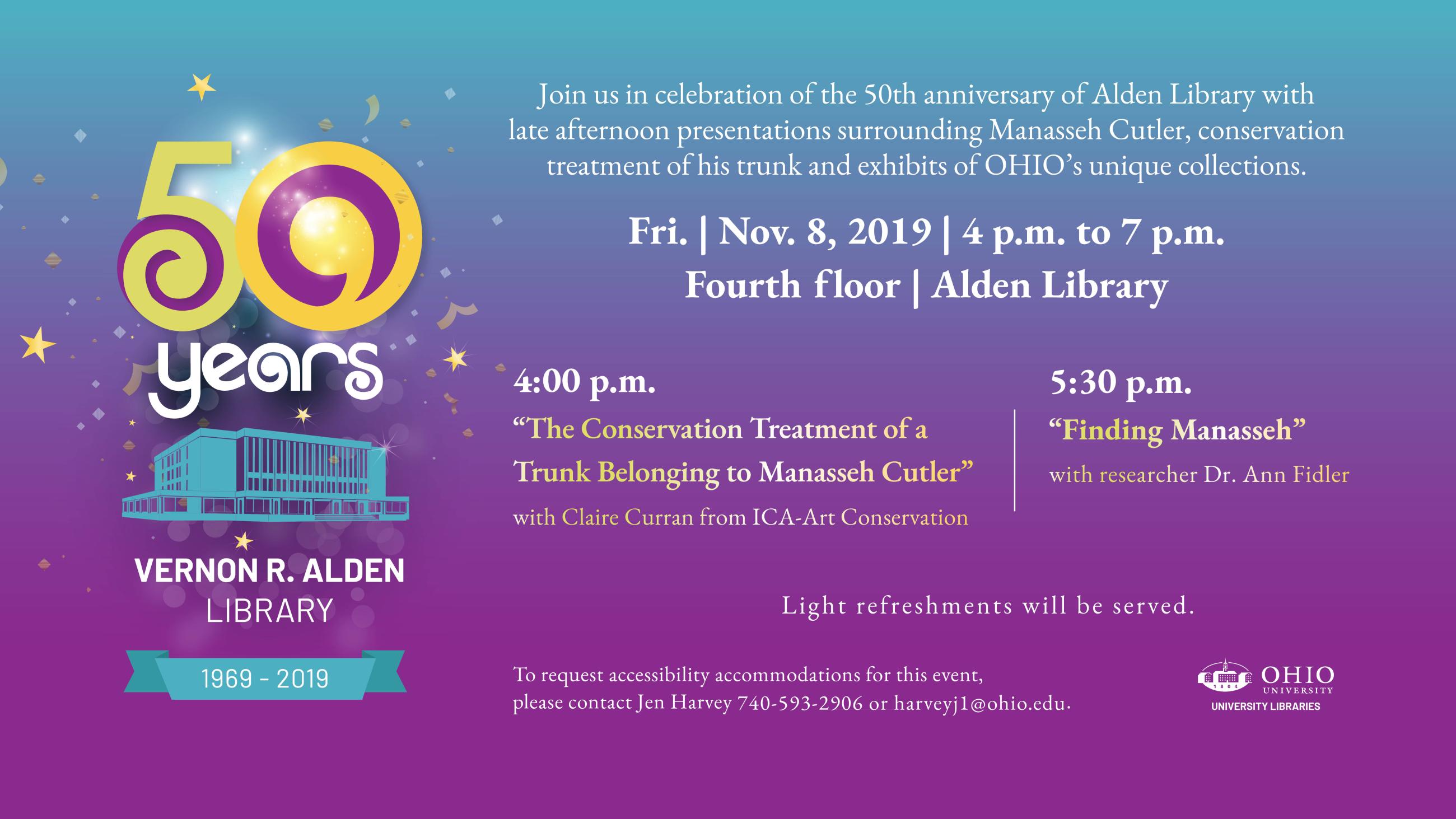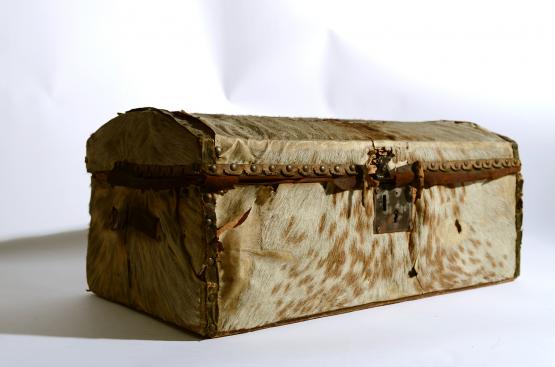
Celebrating 50 Years of Alden Library with OHIO’s founder, Manasseh Cutler

Join us in celebration of the 50th anniversary of Alden Library with late afternoon presentations surrounding Manasseh Cutler, the founder of Ohio University, by historian, Dr. Ann Fidler, who will examine the life and legacy of Cutler in “Finding Manasseh;” and by Claire Curran, assistant objects conservator from ICA-Art Conservation in Cleveland, in “The Conservation Treatment of a Trunk Belonging to Manasseh Cutler.”
Along with the two presentations held Friday, Nov. 8 from 4-7 p.m. on the fourth floor of Alden Library, there will be exhibits of OHIO’s unique collections, a reception of light hors d’oeuvres and music from the Woodstock era. The event is free and open to the public.
About “Finding Manasseh” from 5:30-6:30 p.m.
An ordained minister, Yale graduate, and father of eight children, Manasseh Cutler (1742-1823) was instrumental in the formation of the Ohio Company of Associates, whose purpose was not only the purchase of land in the old Northwest Territory, but according to “200 Years of Shared Discovery,” the acquisition of a 46,800-acre land grant from Congress to establish a university. Although surveyed in 1799, it was not until 1804 that Ohio University was established.
Speaker, Dr. Ann Fidler, became intrigued with Cutler’s personality, accomplishments and his association with OHIO after encountering a copy of the “Life, Journals and Correspondence of Rev. Manasseh Cutler” while working in her Cutler Hall office several years ago.
“One of my jobs in the provost’s office was to do speech writing. And as a historian working at a University that had an intriguing history, I was always trying to incorporate historical events, ideas and people into my speeches. So, it was very natural for me seeing those books on the shelf, to pull them down and start looking through them,” explains Fidler.
Fidler later learned that the books, produced by his granddaughter, Julia Perkins Cutler, and grandson, William Parker Cutler, had been selectively edited to enhance the historical reputation of the Cutler family, and that there was much more unpublished archival material to explore. This discovery led Fidler to embark upon her own journey of writing about Cutler’s life and legacy.
While her biographical account of Cutler is still a work in progress, Fidler finds what she has learned, so far, to be compelling.
“To date, Manasseh’s life has been rendered selectively by proud descendants or glancingly by historians using broad strokes. What is missing is a full and frank account of a man who was by turns brilliant, anxious, curious, vain, mischievous, downhearted and driven, sometimes to unfortunate ends, by his sense of duty and honor,” wrote Fidler.
What is great about this undertaking, explains Fidler, is she is forced to learn something about everything — the history of botany, astronomy, early American politics — and the massive Ohio Company of Associates project, all of which is daunting, but also one of the things she likes about the project.
“It is a vast canvas, and he walks through it all,” she says.
The guiding theme throughout Fidler’s research is Cutler’s identity. He lived during the American Revolution and the Early National Period, she says, when things around him were changing rapidly. He went down many avenues, and some of the roads taken were more successful than others.

“What I am trying to do in my talk is flesh out a little bit of who he is by using things that he either owned or are associated with him. This is driven by the [Cutler] trunk…an artifact Ohio University owns that has been restored, hopefully, in all its glory.”
The trunk, she suggests, can be used as a way to explore not only what Cutler physically carried but also some of the assumptions that he brought with him about Native Americans and the possession of land. Other artifacts will be used to discuss his work as a congregational minister and his experiences as a politician.
Fidler hopes the audience, who may know Cutler only as the sedate person gazing out of his portrait in the University, will walk away from her talk with a better appreciation of the unique man behind the establishment of OHIO.
“He was fun; he had interesting children; his wife was interesting; and he knew a lot of interesting people. It is a kaleidoscope of cool people, things, places and ideas,” Fidler says with a chuckle.
“The Conservation Treatment of a Trunk Belonging to Manasseh Cutler” from 4-5 p.m.
Speaker, Claire Curran, will spend a little bit of time talking about what conservation is, but most of what she will focus on is the conservation treatment of the Cutler trunk itself— how she assesses and executes the treatment of the trunk, and then she explains why she did what she did, and its long-term impact on the trunk.
Curran, who spent two years at the Smithsonian's Hirshhorn Museum and Sculpture Garden, and time abroad in Copenhagen at the Staten Museum for Kunst and the National Museum of Denmark before completing her master’s from Winterthur/ University of Delaware Program in Art Conservation, a program that only accepts 10 students every year, is experienced in the small, specialized field of objects conservation and ascertaining the needed treatment to stabilize the Cutler trunk.
“One of the first things I do when I look at an object is [to] determine the materials, how it is made, and the overall structure. [With this object] the structure is the wood frame of the trunk. And that was relatively stable… Then what I looked at, was the covering or material on the wood frame or substrate. That would be deerskin, and that was not stable,” explains Curran.
There are two areas that conservators concentrate on, says Curran, stabilization, which is physically putting the material in a state that is safer and less likely to get damaged, and looking at the aesthetics — purely what it looks like to the public.
“My main goal with the Cutler trunk was making sure that the skin was better attached to the wood frame. So that when it was handled, or stored, or exhibited there was less of a chance for damage,” explains Curran. “Our biggest concern [as conservators] is stability as we care most about preservation of the physical object over time... and overall aesthetic appearance.”
Be sure to mark your calendar for Nov. 8 from 4-7 p.m. to hear more from experts Claire Curran and Dr. Ann Fidler in celebration of Alden’s 50th birthday!
To request accessibility accommodations for this event, please contact Jen Harvey.